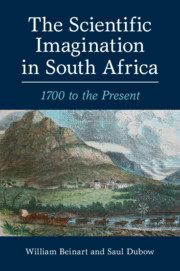Book contents
- The Scientific Imagination in South Africa
- The Scientific Imagination in South Africa
- Copyright page
- Contents
- Map
- Figures
- Acknowledgements
- Introduction: The Scientific Imagination in South Africa
- 1 Scientific Imagination and Local Knowledge at the Cape in the Eighteenth Century
- 2 Scientific Governance and Colonial Institutions, c. 1800–70
- 3 Technological Innovation and the Scientific Imagination in Mining and Agriculture, 1870–1902
- 4 Science, Reconstruction and the Imagining of the First ‘New’ South Africa, 1902–29
- 5 The Commonwealth of Knowledge, 1930–48
- 6 The Republic of Science, 1948–90
- 7 Big Science and Indigenous Knowledge: Post-Apartheid South Africa and the African Renaissance
- Afterword
- Select Bibliography
- Index
3 - Technological Innovation and the Scientific Imagination in Mining and Agriculture, 1870–1902
Published online by Cambridge University Press: 07 May 2021
- The Scientific Imagination in South Africa
- The Scientific Imagination in South Africa
- Copyright page
- Contents
- Map
- Figures
- Acknowledgements
- Introduction: The Scientific Imagination in South Africa
- 1 Scientific Imagination and Local Knowledge at the Cape in the Eighteenth Century
- 2 Scientific Governance and Colonial Institutions, c. 1800–70
- 3 Technological Innovation and the Scientific Imagination in Mining and Agriculture, 1870–1902
- 4 Science, Reconstruction and the Imagining of the First ‘New’ South Africa, 1902–29
- 5 The Commonwealth of Knowledge, 1930–48
- 6 The Republic of Science, 1948–90
- 7 Big Science and Indigenous Knowledge: Post-Apartheid South Africa and the African Renaissance
- Afterword
- Select Bibliography
- Index
Summary
Technical innovation in agriculture preceded that in mining, and the value of colonial agricultural production exceeded that of diamonds throughout the nineteenth century. After the Cape received responsible government in 1874 a colonial scientific bureaucracy was gradually expanded to include a veterinary surgeon, a Department of Agriculture, and a state botanist, geologist, entomologist and marine biologist. The discovery of diamonds in the 1860s and Witwatersrand gold in the 1880s reshaped the contours of race and science. Mining became reliant on increasingly sophisticated technology and on cheap black labour. Rapid growth in the mining sector has been analysed by historians in terms of the relationship between capital and labour. Scientific and technological innovations were also critical: applied geology, water pumps, explosives, stamping gear and the recently discovered cyanide process for gold extraction. The geostrategic importance of southern Africa became a point of growing competition, and the borders of a unitary South African state in 1910 emerged out of wars of conquest against African societies and intense conflict between English- and Dutch-speaking citizens. Imperial conquest and expansion were in turn associated with rapid technological change: steamships, railways, transatlantic cables and breech loading rifles. Together these constituted a ‘full-blown socio-technical imaginary’.
Keywords
- Type
- Chapter
- Information
- The Scientific Imagination in South Africa1700 to the Present, pp. 109 - 154Publisher: Cambridge University PressPrint publication year: 2021



